Crafting Urban Landscapes and Monumental Infrastructure: Archaeometric Investigations of White Marble Architectural Elements from Roman Philippopolis (Bulgaria)
Abstract
1. Introduction
2. The Case Study of the Eastern Gate
The Sampled Artefacts
3. Archaeometric Methodology
4. Provenance Results
4.1. Petrographic Data
4.2. Geochemical Data
- Distance: Distance of the sample under consideration from the centre of the ellipse. This centre is the average value of the quarry probability field.
- Relative (posterior) probability: This probability is the degree of likelihood of a sample belonging to a given group (within the selected number of groups). Results below 60% indicate that the sample probably cannot be assigned with certainty and that a second choice has to be considered.
- Absolute (typical) probability: This is the measure of the probability that a sample belongs to a given population. Samples in the centre of the probability ellipse have a high absolute probability. The threshold is 10%, corresponding to samples on the edge of the 90% probability ellipse. Low values indicate anomalous samples (outliers) or samples possibly not belonging to any group in the selection.
5. Discussion
5.1. The Building Materials
5.2. Chronological Remarks
5.3. Architectural Remarks
5.4. Archaeometric Results of Other Building Complexes of Philippopolis
5.5. Remarks on the Wider Context of Roman Stone Trade
6. Conclusions
Supplementary Materials
Author Contributions
Funding
Data Availability Statement
Acknowledgments
Conflicts of Interest
References
- Lozanov, I. Belezhki varhu razvitieto na Filipopol v rannata istoriya na rimska Trakiya (I v.–parva chetvart na II v.). God. Sofiisk. Univ. Istor. Fak. 2002, 3, 231–244. [Google Scholar]
- Topalilov, I. The Issues of Urban Development of Philippopolis throughout the 1st—The Beginning of the 4th C. AD. In Roman and Early Byzantine Settlements in Bulgaria; Ivanov, R., Ed.; Professor Marin Drinov Academic Publishing House at the Bulgarian Academy of Sciences: Sofia, Bulgaria, 2008; Volume III, pp. 162–203. [Google Scholar]
- Andreeva, P.; Anevlavi, V.; Frerix, W.; Cenati, C.; Prochaska, W.; Ladstätter, S.; Karadimitrova, K. A contribution to the urbanization and marble supply of Roman Thrace: An interdisciplinary study. Archaeol. Anthropol. Sci. 2024, 16, 23. [Google Scholar] [CrossRef]
- Kovachev, V. (Ed.) Gold, Copper Mining and Geoarchaeology in Central Bulgaria; University of Szeged Department of Mineralogy, Geochemistry and Petrology: Szeged, Hungary, 2010. [Google Scholar]
- Dimitrov, Z. The monumental arches in Gerasa (Jerash, Jordan) and Philippopolis (Plovdiv, Bulgaria): A case study in parallel examples from the Hadrianic era. Stud. Hist. Archaeol. Jordan 2013, 9, 803–815. [Google Scholar]
- Dimitrov, Z. Razvitie na korintskiya order vav Filipopol prez rimskata epoha. God. Muz. Plovdiv 2009, 11, 85–114. [Google Scholar]
- Vermeulen, F.; Zuiderhoek, A. The economics of space and mobility in Roman urbanism. In Space, Movement and the Economy in Roman Cities in Italy and Beyond; Routledge: London, UK, 2021; pp. 419–425. [Google Scholar]
- Tanner, J.; Gardner, A. (Eds.) Materialising the Roman Empire; UCL Press: London, UK, 2024. [Google Scholar]
- Taelman, D. Marble trade in the Roman Mediterranean: A quantitative and diachronic study. J. Roman Archaeol. 2022, 35, 848–875. [Google Scholar] [CrossRef]
- Blackburn, W.H.; Dennen, W.H. Principles of Mineralogy; Wm. C. Brown Publishers: Dubuque, IA, USA, 1994. [Google Scholar]
- Antonelli, F.; Columbu, S.; Lezzerini, M.; Miriello, D. Petrographic Characterisation and Provenance Determination of the White Marbles Used in the Roman Sculptures of Forum Sempronii (Fossombrone, Marche, Italy). Appl. Phys. A Mater. Sci. Process. 2014, 115, 1033–1040. [Google Scholar] [CrossRef]
- Herz, N. Provenance Determination of Neolithic to Classical Mediterranean Marbles by Stable Isotopes. Archaeometry 1992, 34, 185–194. [Google Scholar] [CrossRef]
- Topalilov, I. The Importance of the So-Called ‘Eastern Gate’ Complex for the Christians and Christianity in LA Philippopolis. In Cities and Citizens in Byzantine World; Rakocija, M., Ed.; Niš and Byzantium: Niš, Serbia, 2016; Volume 14, pp. 265–274. [Google Scholar]
- Martinova-Kyutova, M.; Pirovska, G. Iztochnata porta na Filipopol. In Izsledvaniya v Chest na Stefan Boyadzhiev; Stanev, S., Grigorov, V., Dimitrov, V., Eds.; National Archaeological Institute with Museum, Bulgarian Academy of Sciences: Sofia, Bulgaria, 2011; pp. 211–234. [Google Scholar]
- Martinova-Kyutova, M.; Sharankov, N. Novi danni za kompleksa Iztochna porta na Filipopol. God. Reg. Arheol. Muz. Plovdiv 2014, XII, 159–184. [Google Scholar]
- Ivanov, R. (Ed.) Tabula Imperii Romani. K35/2; Tendril Publishing House: Sofia, Bulgaria; Philippopolis, Bulgaria, 2012. [Google Scholar]
- Anevlavi, V.; Prochaska, W.; Cenati, C.; Ivanov, I.; Ladstätter, S.; Popov, H.; Georgiev, P.; Kabakchieva, G. Geochemical and petrographic investigation of the provenance of white marble decorative elements from the Roman Villa Armira in south-eastern Bulgaria. Archaeol. Anthropol. Sci. 2022, 14, 229. [Google Scholar] [CrossRef]
- Topalilov, I. The Emperor and the City: A Case Study on the Link Between Hadrian and Philippopolis, Thrace. In The Roman Empire and Beyond: Archaeological and Historical Research on the Romans and Native Cultures in Central Europe; De Sena, E.C., Dobrzanska, H., Eds.; BAR Int. Ser. 2236; Archaeopress: Oxford, UK, 2011; pp. 23–33. [Google Scholar]
- Dimitrov, Z. Anatolian Elements in the Order Architecture of Philippopolis. In Proceedings of the First International Roman and Late Antique Thrace Conference (Plovdiv, Bulgaria, 3–7 October 2016); Vagalinski, L., Raycheva, M., Boteva, D., Sharankov, N., Eds.; National Archaeological Institute with Museum at the Bulgarian Academy of Sciences (NAIM-BAS): Sofia, Bulgaria, 2018; pp. 231–243. [Google Scholar]
- Koleva, M. Rimska Idealna Skulptura ot Balgariya; Bulgarian Academy of Sciences: Sofia, Bulgaria, 2017. [Google Scholar]
- Anevlavi, V.; Prochaska, W.; Dimitrov, Z.; Ladstätter, S. Provenance Matters. A Multi-Proxy Approach for the Determination of White Marbles from Villa Armira, Bulgaria. In Proceedings of the ASMOSIA XII—Association for the Study of Marble & Other Stones in Antiquity XII, Izmir, Turkey, 8–14 October 2018; International Conference Proceedings. Yavuz, A.B., Yolaçan, B., Bruno, M., Eds.; Dokuz Eylül University Publications: Izmir, Turkey, 2023; pp. 165–174. [Google Scholar]
- Anevlavi, V.; Cenati, C.; Prochaska, W.; Dimitrov, Z.; Ladstätter, S. Preliminary investigation of white marble quarries in Roman Thrace: The example of south-eastern Bulgaria. In Hergestellt und aufgestellt. Produktionsdynamiken und Kontexte römischer Skulptur im antiken Mittelmeerraum; Landskron, A., Ed.; Keryx, 12; Uni-Press Graz Verlag GmbH: Graz, Austria, 2024; pp. 27–42. [Google Scholar]
- Prochaska, W.; Attanasio, D. The challenge of a successful discrimination of ancient marbles (part I): A databank for the marbles from Paros, Prokonnesos, Heraklea/Miletos and Thasos. J. Archaeol. Sci. Rep. 2021, 35, 102676. [Google Scholar] [CrossRef]
- Prochaska, W.; Attanasio, D. The challenge of a successful discrimination of ancient marbles (part III): A databank for Aphrodisias, Carrara, Dokimeion, Göktepe, Hymettos, Parian Lychnites and Pentelikon. J. Archaeol. Sci. Rep. 2022, 45, 103582. [Google Scholar]
- Prochaska, W.; Ladstätter, S.; Anevlavi, V. The challenge of a successful discrimination of ancient marbles (part IV): A databank for the white marbles from the region of Ephesos. J. Archaeol. Sci. Rep. 2024, 53, 104336. [Google Scholar] [CrossRef]
- Prochaska, W.; Anevlavi, V.; Chakarov, K.; Andreeva, P.; Sutev, I. Archaeometric Investigations on the Significance of Limestones in the Roman Provinces of the Southern Lower Danube. Minerals 2025, 15, 267. [Google Scholar] [CrossRef]
- Antonelli, F.; Lazzarini, L. An Updated Petrographic and Isotopic Reference Database for White Marbles Used in Antiquity. Rend. Lincei 2015, 26, 399–413. [Google Scholar] [CrossRef]
- Columbu, S.; Antonelli, F.; Lezzerini, M.; Miriello, D.; Adembri, B.; Blanco, A. Provenance of Marbles Used in the Heliocaminus Baths of Hadrian’s Villa (Tivoli, Italy). J. Archaeol. Sci. 2014, 49, 332–342. [Google Scholar] [CrossRef]
- Vaiglova, P. How Can We Improve Statistical Training in Archaeological Science? J. Archaeol. Sci. 2025, 179, 106220. [Google Scholar] [CrossRef]
- Glascock, M.D.; MacDonald, B.L. Multivariate Analysis in Archaeology. In Handbook of Archaeological Sciences, 2nd ed.; Elsevier: Amsterdam, The Netherlands, 2023; pp. 1183–1192. [Google Scholar]
- Beauchemin, D. Inductively coupled plasma mass spectrometry. Anal. Chem. 2006, 78, 4111–4136. [Google Scholar] [CrossRef]
- Poretti, G. In Situ Analysis of White Marble from the Mediterranean Basin by LA-ICP-MS: Inferences on Provenance Based on Trace-Element Profiles. Ph.D. Thesis, Sapienza – University of Rome, Rome, Italy, 24 October 2016. [Google Scholar]
- Lepsius, G.R. Griechische Marmorstudien; Verlag der Königlichen Akademie der Wissenschaften: Berlin, Germany, 1890. [Google Scholar]
- Anevlavi, V.; Prochaska, W.; Andreeva, P.; Ladstätter, S. New Evidence of the Supra-Regional Marble Trade Network in Thrace, through the Archaeometric Study of Sculptures in Roman Philippopolis. J. Archaeol. Sci. 2025, 174, 106128. [Google Scholar] [CrossRef]
- Poretti, G.; Brilli, M.; De Vito, C.; Conte, A.M.; Borghi, A.; Günther, D.; Zanetti, A. New considerations on trace elements for quarry provenance investigation of ancient white marbles. J. Cult. Herit. 2017, 28, 16–26. [Google Scholar] [CrossRef]
- Polikreti, K. Detection of ancient marble forgery: Techniques and limitations. Archaeometry 2007, 49, 603–619. [Google Scholar] [CrossRef]
- Craig, H.; Craig, V. Greek marbles: Determination of provenance by isotopic analysis. Science 1972, 176, 401–403. [Google Scholar] [CrossRef] [PubMed]
- Bowen, R. Isotopes in the Earth Sciences; Elsevier Applied Science: London, UK, 1988. [Google Scholar]
- Attanasio, D.; Brilli, M.; Ogle, N. The Isotopic Signature of Classical Marbles; L’Erma di Bretschneider: Rome, Italy, 2006. [Google Scholar]
- Coleman, M.; Walker, S. Stable isotope identification of Greek and Turkish marbles. Archaeometry 1979, 21, 107–112. [Google Scholar] [CrossRef]
- Toma, N. Marble Trade in Moesia Inferior. The Case of Tomis and Odessos. Its Origin and Its Characteristics. In ASMOSIA IX: Proceedings of the IX. Asmosia Conference of 2009, Tarragona; Garcia-M., A.G., Mercadal, P.L., Rodà de Llanza, I., Eds.; Institut Català d’Arqueologia Clàssica: Tarragona, Spain, 2012; pp. 549–559. [Google Scholar]
- Toma, N. Standardization and mass customization of architectural components: New perspectives on the Imperial marble construction industry. J. Roman Archaeol. 2018, 31, 161–191. [Google Scholar] [CrossRef]
- Sillar, B.; Tite, M.S. The challenge of ‘technological choices’ for materials science approaches in archaeology. Archaeometry 2000, 42, 2–20. [Google Scholar] [CrossRef]
- Davis, H. The Culture of Building; Oxford University Press: Oxford, UK, 2006. [Google Scholar]
- Ulrich, R.B.; Quenemoen, C.K. (Eds.) A Companion to Roman Architecture; Wiley-Blackwell: Malden, MA, USA, 2013. [Google Scholar]
- Vandeput, L. The Architectural Decoration in Roman Asia Minor: Sagalassos: A Case Study; Brepols: Turnhout, Belgium, 1997. [Google Scholar]
- Taelman, D. Contribution to the use of marble in Central-Lusitania in Roman times: The stone architectural decoration of Ammaia (São Salvador da Aramenha, Portugal). Arq. Esp. Arqueol. 2014, 87, 175–194. [Google Scholar] [CrossRef]
- Moreira, N.; Pedro, J.; Lopes, L.; Carneiro, A.; Mourinha, N.; Araújo, A.; Santos, J.F. The Ossa-Morena marbles used in Classical Antiquity: Review of their petrographic features and isotopic data. Comun. Geol. 2020, 107, 81–89. [Google Scholar][Green Version]
- Prochaska, W. The challenge of a successful discrimination of ancient marbles (part II): A databank for the Alpine marbles. J. Archaeol. Sci. Rep. 2021, 38, 102958. [Google Scholar] [CrossRef]
- Djurić, B. The Logistics behind Ancient Art. The Case of Noricum and Pannoniae. In Akten des 15. Internationalen Kolloquiums zum Provinzialrömischen Kunstschaffen. Der Stifter und sein Monument: Gesellschaft–Ikonographie–Chronologie; Porod, B., Scherrer, P., Eds.; Universalmuseum Joanneum: Graz, Austria, 2019; pp. 8–38. [Google Scholar]
- Taelman, D. Mapping architectural white marble use in Roman Italy: A quantitative study of archaeometric provenance data. Rend. Lincei Sci. Fis. Nat. 2025, 36, 23–38. [Google Scholar] [CrossRef]
- Maniatis, Y. To μάρμαρο για την λατρεία, την τέχνη και την αρχιτεκτονική: από την προϊστορική Ελλάδα ως την σύγχρονη Δύση. In Πρακτικά Συνεδρίου ‘H επίδραση του Oλυμπιακού Πνεύματος στην ανθρώπινη πρόοδο’; Hellenic Ministry of Culture–Ephorate of Antiquities of Thessaloniki: Thessaloniki, Greece, 2003; pp. 232–249. [Google Scholar]
- Maniatis, Y. Scientific techniques and methodologies for the provenance of white marble. In Physics Methods in Archaeometry; Martini, M., Milazzo, M., Piacentini, M., Eds.; IOS Press: Amsterdam, The Netherlands, 2004; pp. 179–202. [Google Scholar]
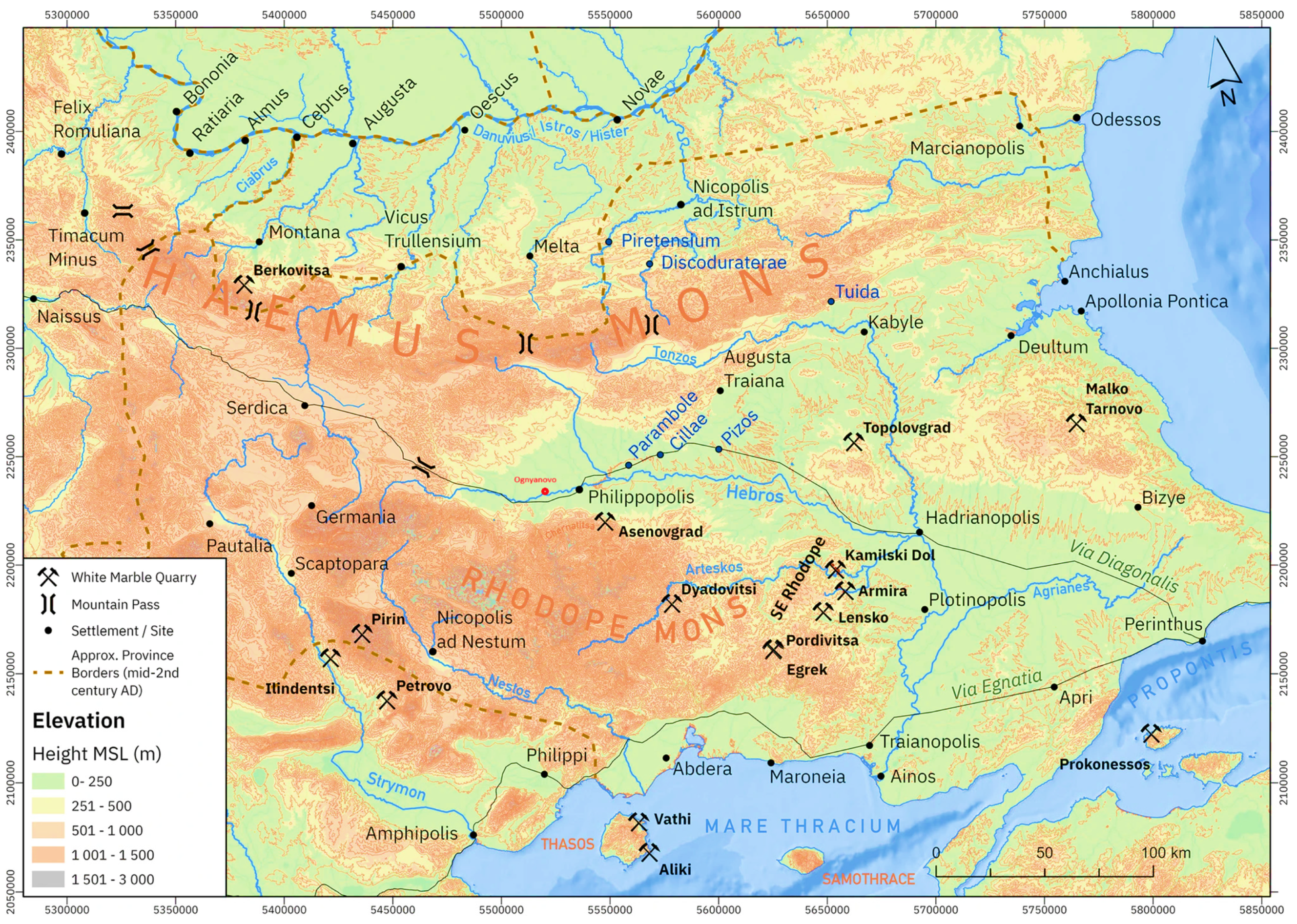
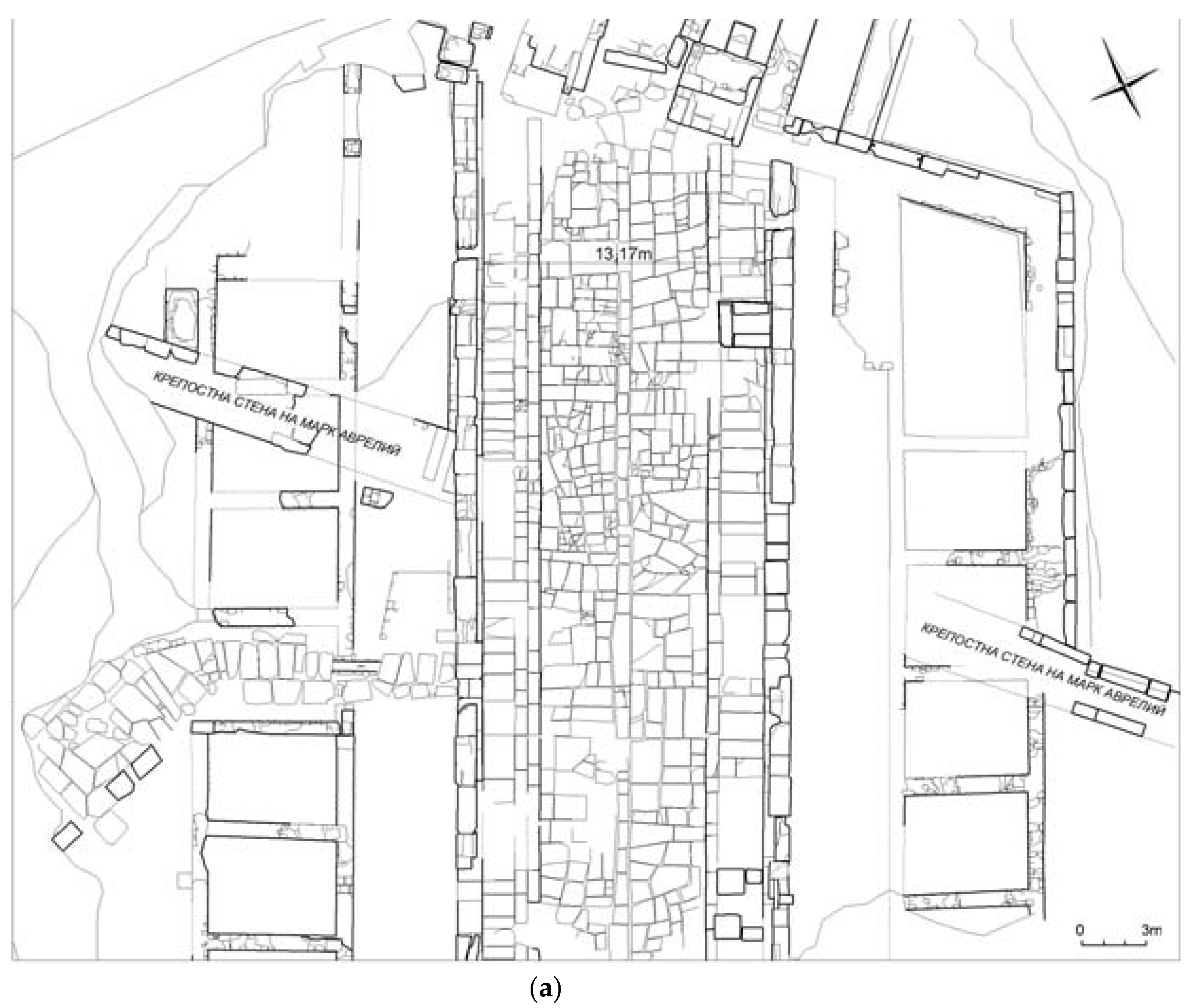
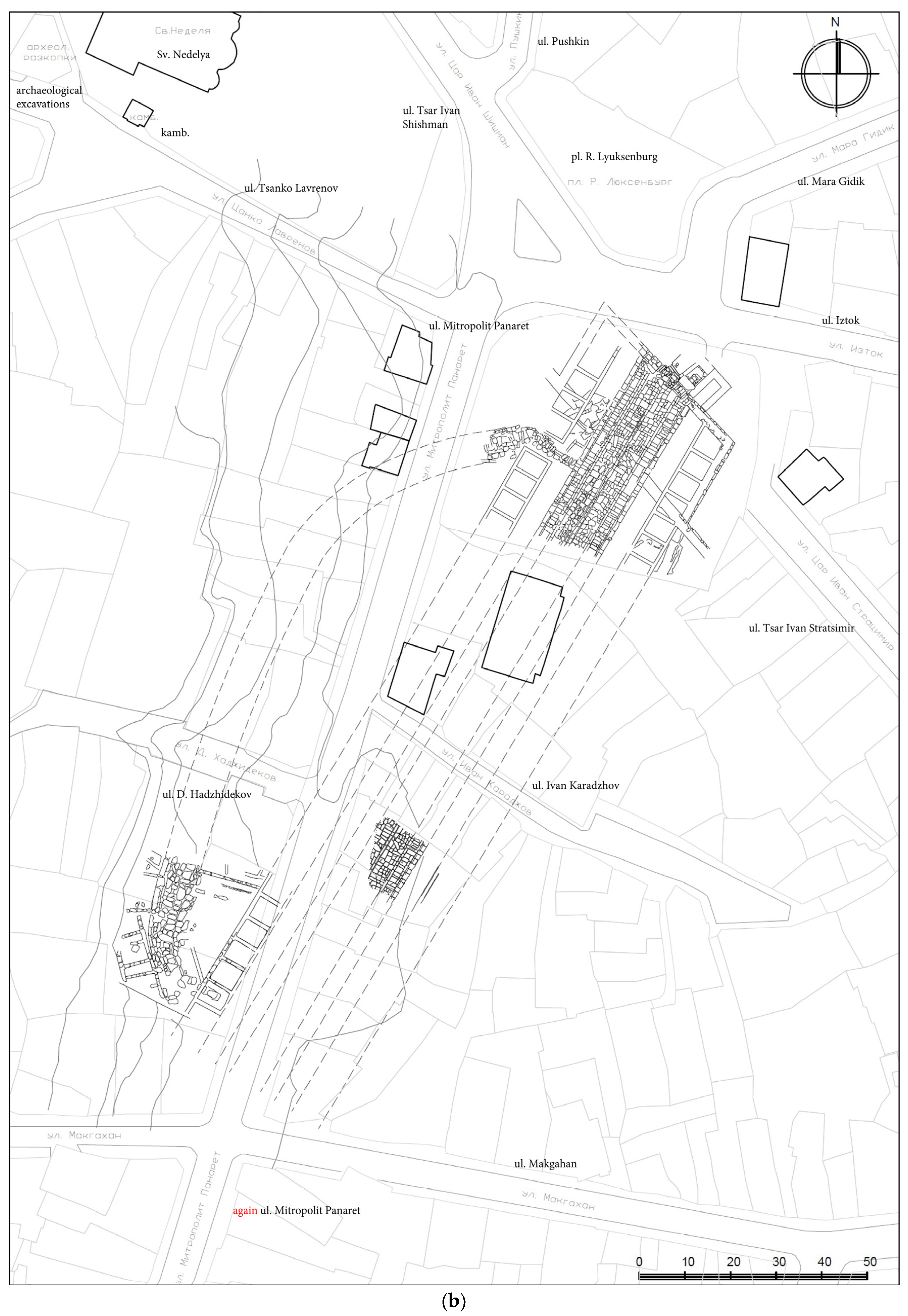
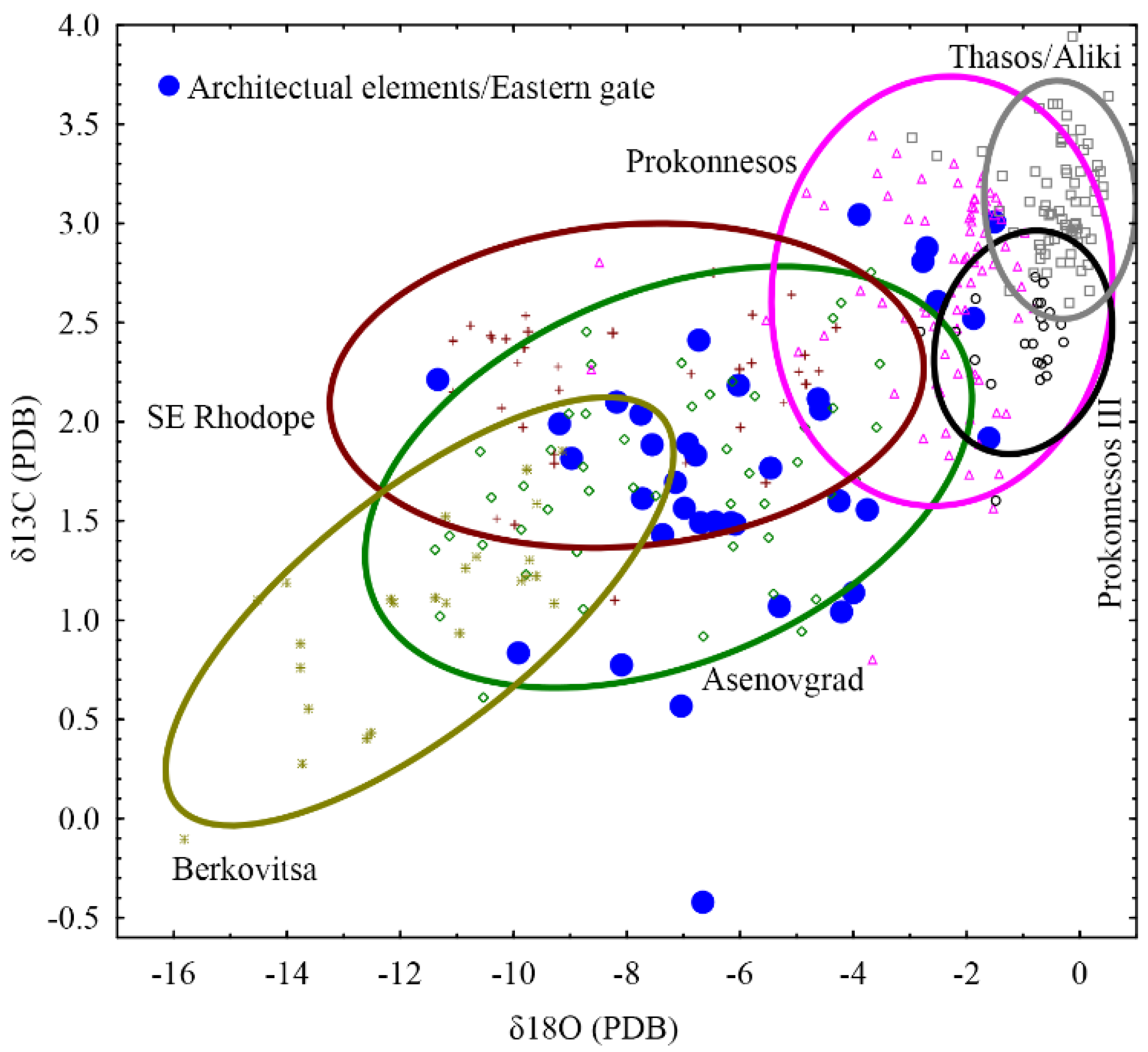
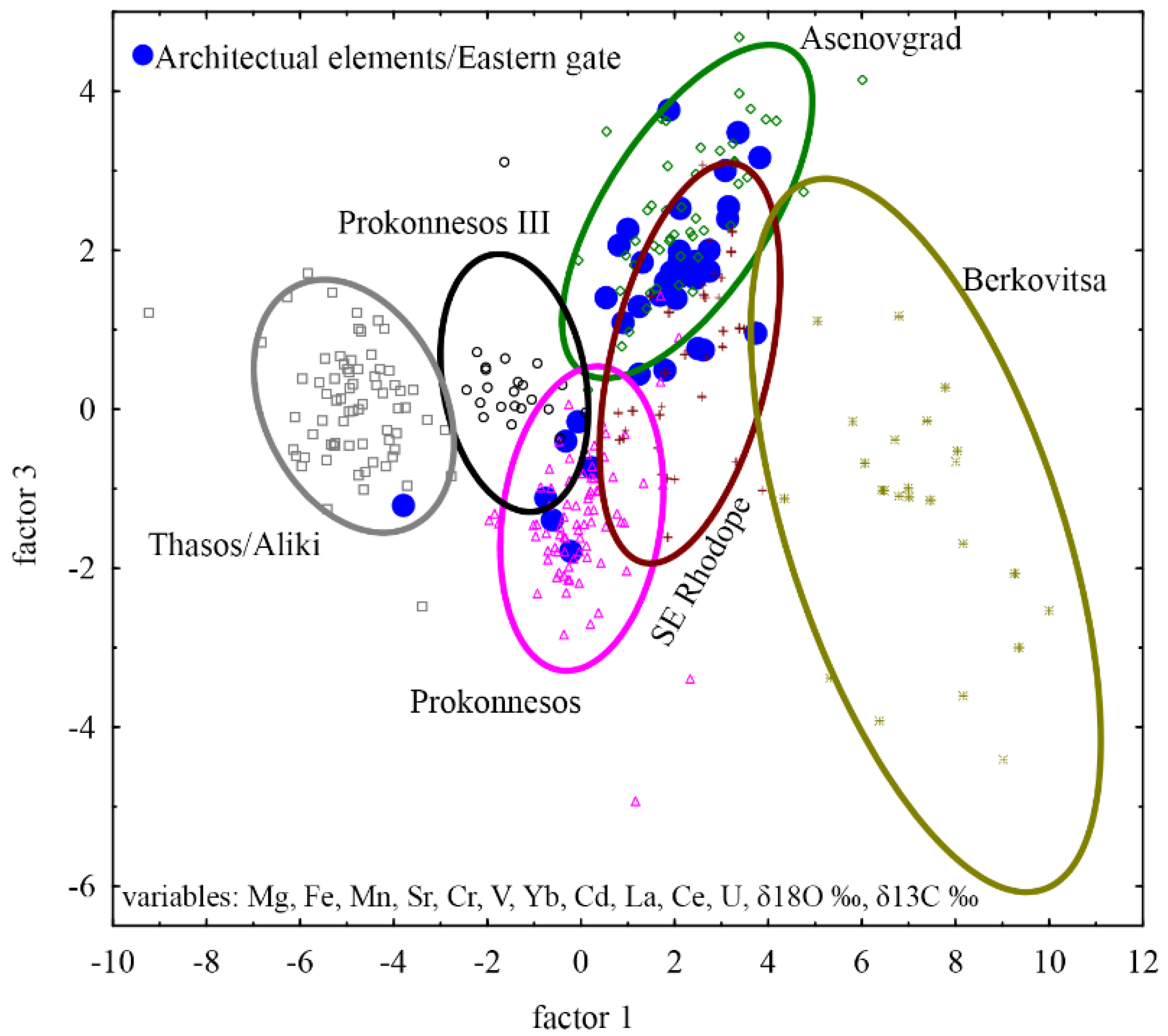

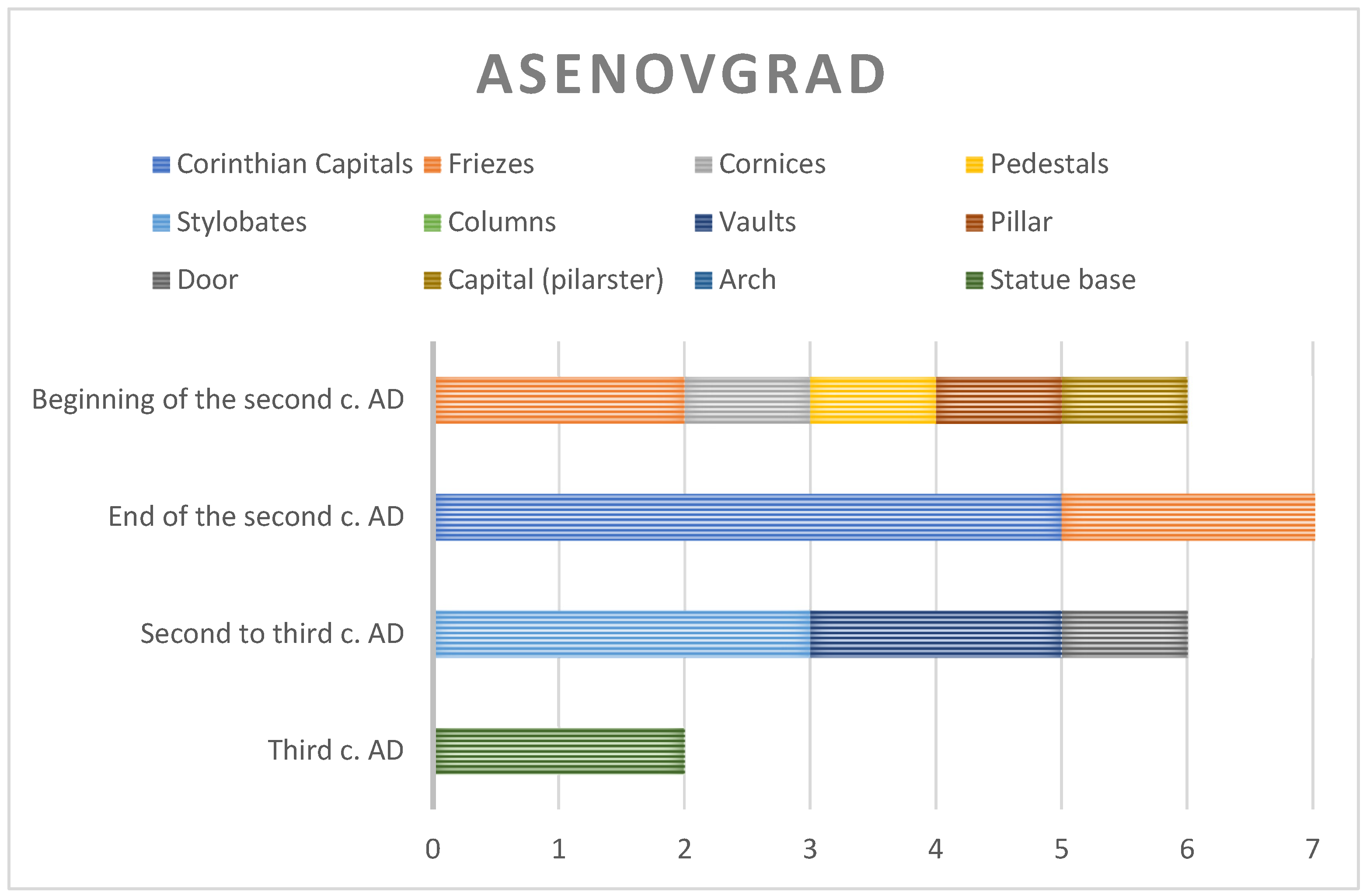
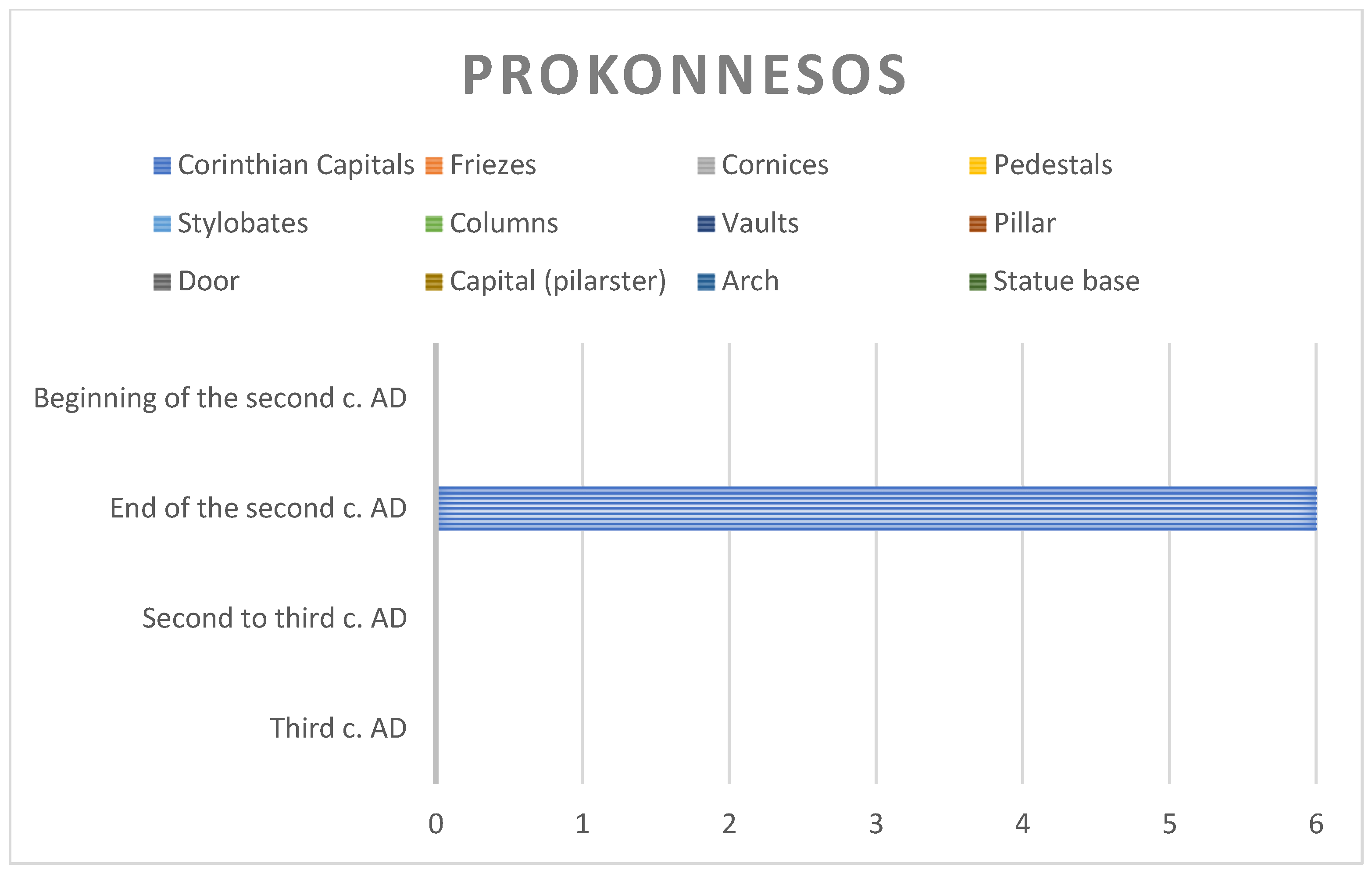
| Lab Nr | Project Nr | M. Nr | Object | Material | Marble Description | Dating | Location | Find Spot | Details on Finding Spot | Provenance Results | Photo | Bibliography |
|---|---|---|---|---|---|---|---|---|---|---|---|---|
| 9722 | FWM0364 | n/a | Frieze-architrave | Marble | White colour; coarse-grained with fine matrix, grey specks | First half of the second century AD, probably Hadrianic period | In situ | Plovdiv | Eastern gate | Asenovgrad |  | [18], p. 32; [15], p. 166 |
| Description: Fragment of a frieze-architrave block with a Greek inscription. The architrave is divided into three protruding fasciae, and the inscription (AYTO) is incised on the uppermost fascia. The moulding between the architrave and the frieze, and the decoration of the frieze itself, are not preserved. | ||||||||||||
| 9723 | FWM0365 | 101 | Statue base | Marble | White colour; coarse-grained; ultra-fine layers | First half of the third century AD | In situ | Plovdiv | Eastern gate | Asenovgrad | 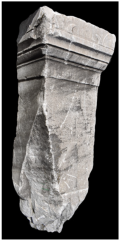 | [15], p. 180 |
| Description: With a Greek inscription. The lower part of the pedestal is broken off. The moulding of the upper part is adorned with stylised acroteria. | ||||||||||||
| 9724 | FWM0366 | n/a | Pedestal | Marble | White colour; coarse-grained with fine-grained veins | Hadrianic period | In situ | Plovdiv | Eastern gate | Asenovgrad | 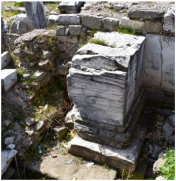 | [14] |
| Description: Part of one of the pillars of the honorary arch. Parallelepiped shape, smooth surface, and profiled upper and lower end. The pedestal stands on a profiled plinth. | ||||||||||||
| 9725 | FWM0367 | n/a | Pilaster | Marble | White/beige colour; coarse-grained with fine-grained veins | Hadrianic period | In situ | Plovdiv | Eastern gate | Asenovgrad |  | [6,14] |
| Description: From the honorary arch, used as spolia in the Late Antique gate. Corner pilaster with two adjacent decorated sides, of which only one is preserved and visible today. The front side is surrounded by a profiled frame, in the centre of which there is relief decoration of acanthus scrolls. The moulding of the frame consists of bead-and-reel and leaf-and-dart. | ||||||||||||
| 9726 | FWM0368 | n/a | Block | Marble | White colour; coarse-grained with fine-grained veins | Second to third century AD | In situ | Plovdiv | Eastern gate | Asenovgrad | 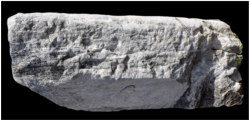 | n/a |
| Description: Used as a door frame. Block with parallelepiped shape, without decoration. The upper part is broken off. | ||||||||||||
| 9727 | FWM0369 | n/a | Block | Marble | White colour; coarse-grained with fine-grained veins | Second to third century AD | In situ | Plovdiv | Eastern gate | Asenovgrad |  | [14] |
| Description: From the northern stylobate of the colonnade along the street. The block has a parallelepiped shape. | ||||||||||||
| 9728 | FWM0370 | n/a | Block | Marble | White colour; coarse-grained with fine-grained veins | Second to third century AD | In situ | Plovdiv | Eastern gate | Asenovgrad |  | [14] |
| Description: From the northern stylobate of the colonnade along the street. The block has a parallelepiped shape. | ||||||||||||
| 9729 | FWM0371 | n/a | Block | Marble | White colour; coarse-grained with fine-grained veins | Second to third century AD | In situ | Plovdiv | Eastern gate | Asenovgrad |  | [14] |
| Description: From the northern stylobate of the colonnade along the street. The block has a parallelepiped shape. | ||||||||||||
| 9730 | FWM0372 | n/a | Block with unfinished decoration | Marble | White colour; coarse-grained with fine-grained veins | End of the second to the first decades of the third century AD | In situ | Plovdiv | Eastern gate | Asenovgrad | 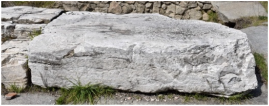 | n/a |
| Description: Reused in the northern stylobate of the colonnade along the street. The block has a parallelepiped shape. At the upper left end of the block, there is a horizontal decoration of egg-and-dart. | ||||||||||||
| 9731 | FWM0373 | 2 | Corinthian column capital | Marble | White/brownish/beige/greyish colour; coarse-grained | Middle to second half of the second century AD | In situ | Plovdiv | Eastern gate | Asenovgrad | 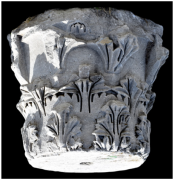 | [5,6] |
| Description: Normal Corinthian capital, Asiatic type. The helices are shaped differently. Three of the abacus flowers and three of the corners of the abacus with the adjacent volutes are broken off. | ||||||||||||
| 9732 | FWM0374 | 3 | Corinthian column capital | Marble | White colour; coarse-grained | Severan period | In situ | Plovdiv | Eastern gate | Asenovgrad | 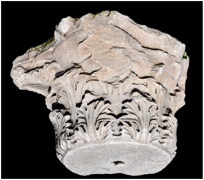 | [14] |
| Description: Corinthian capital, Asiatic type. There are no helices. Three of the corners of the abacus with the adjacent volutes are broken off. | ||||||||||||
| 9733 | FWM0375 | 42 | Corinthian column capital | Marble | White colour; coarse-grained | Severan period | In situ | Plovdiv | Eastern gate | Prokonnesos |  | [14] |
| Description: Corinthian capital, Asiatic type. There are no helices. Two of the corners of the abacus with the adjacent volutes are broken off. | ||||||||||||
| 9734 | FWM0376 | 43 | Corinthian column capital | Marble | White colour; fine to medium-grained | Severan period | In situ | Plovdiv | Eastern gate | Prokonnesos |  | [6,14] |
| Description: Normal Corinthian capital, Asiatic type. There are helices on one side of the capital. All corners of the abacus with the adjacent volutes are broken off. | ||||||||||||
| 9735 | FWM0377 | 44 | Corinthian column capital | Marble | White colour with grey layers; fine to medium-grained | Severan period | In situ | Plovdiv | Eastern gate | Prokonnesos | 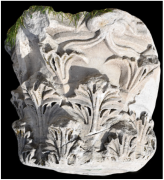 | [14,19] |
| Description: Corinthian capital, Asiatic type. There are no helices. All corners of the abacus with the adjacent volutes are broken off. | ||||||||||||
| 9736 | FWM0378 | 13 | Shaft | Marble | White colour; fine/coarse-grained | Second to the first decades of the third century AD | In situ | Plovdiv | Eastern gate | Asenovgrad |  | [14] |
| Description: Part of a shaft of a free-standing column with a smooth, polished surface. | ||||||||||||
| 9737 | FWM0379 | 27 | Shaft | Marble | White colour; fine-grained | Second to the first decades of the third century AD | In situ | Plovdiv | Eastern gate | Asenovgrad | 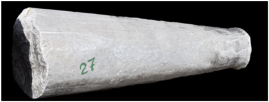 | [14] |
| Description: Upper part of a shaft of a free-standing column with a smooth, polished surface. The neck of the shaft is preserved. | ||||||||||||
| 9738 | FWM0380 | 27 | Shaft | Marble | White/beige colour; coarse-grained | Second to the first decades of the third century AD | In situ | Plovdiv | Eastern gate | Asenovgrad | 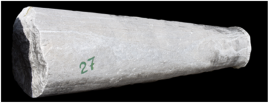 | [14] |
| Description: Upper part of a shaft of a free-standing column with a smooth polished surface. The neck of the shaft is preserved. | ||||||||||||
| 9739 | FWM0381 | 38 | Shaft | Marble | White colour; medium to coarse-grained | Second to the first decades of the third century AD | In situ | Plovdiv | Eastern gate | Asenovgrad |  | [14] |
| Description: Monolithic shaft of a free-standing column with a smooth polished surface. | ||||||||||||
| 9740 | FWM0382 | 52 | Cornice with consoles | Marble | White colour; coarse-grained with fine-grained veins | Severan period | In situ | Plovdiv | Eastern gate | Asenovgrad | 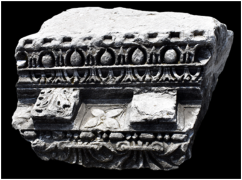 | [14] |
| Description: The mouldings consist of dentils, egg-and-dart, leaf-and-dart, consoles with acanthus leaves and coffers, bead-and-reel, and sima decorated with palmette anthemion. | ||||||||||||
| 9741 | FWM0383 | 57 | Cornice with consoles | Marble | White colour; coarse-grained with fine-grained veins | Severan period | In situ | Plovdiv | Eastern gate | Asenovgrad |  | [14] |
| Description: The mouldings consist of dentils, egg-and-dart, leaf-and-dart, consoles with acanthus leaves and coffers, bead-and-reel, and sima decorated with palmette anthemion. | ||||||||||||
| 9742 | FWM0384 | 85 | Cornice with consoles | Marble | White colour; coarse-grained with fine-grained veins | Severan period | In situ | Plovdiv | Eastern gate | Asenovgrad |  | [14] |
| Description: The mouldings consist of dentils, egg-and-dart, leaf-and-dart, consoles with acanthus leaves and coffers, bead-and-reel, and sima decorated with palmette anthemion. | ||||||||||||
| 9743 | FWM0385 | 94 | Cornice with consoles | Marble | White colour; coarse-grained with fine-grained veins | Severan period | In situ | Plovdiv | Eastern gate | Asenovgrad | 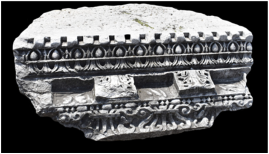 | [14] |
| Description: The mouldings consist of dentils, egg-and-dart, leaf-and-dart, consoles with acanthus leaves and coffers, bead-and-reel, and sima decorated with palmette anthemion. | ||||||||||||
| 9744 | FWM0386 | 60 | Pedestal | Marble | White colour; coarse-grained with fine-grained veins | Second half of the second -beginning of the third century AD | In situ | Plovdiv | Eastern gate | Asenovgrad | 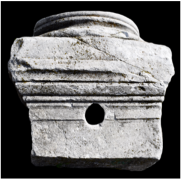 | [14] |
| Description: Part of a pedestal made of a monolithic block together with an Attic-Ionic base for a free-standing column. The lower part is missing. At a later stage, a round hole was drilled just below the upper moulding of the pedestal. | ||||||||||||
| 9745 | FWM0387 | 48 | Pedestal | Marble | White colour; coarse-grained with a fine matrix | Second half of the second to the first decades of the third century AD | In situ | Plovdiv | Eastern gate | Asenovgrad | 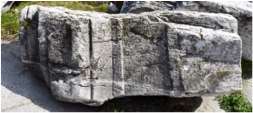 | [14] |
| Description: Part of a pedestal made of a monolithic block together with an Attic-Ionic base for a free-standing column. The lower moulding is broken off. | ||||||||||||
| 9746 | FWM0388 | 80 | Frieze-architrave | Marble | White colour; coarse-grained with fine-grained veins | Severan period | In situ | Plovdiv | Eastern gate | Asenovgrad |  | [14] |
| Description: Block turned upside down. The architrave on the posterior side is divided into three protruding fasciae. Beds for beams are formed above it. The soffit is decorated with a plant motif. | ||||||||||||
| 9747 | FWM0389 | 87 | Frieze-architrave | Marble | White colour; coarse-grained with fine-grained veins | Severan period | In situ | Plovdiv | Eastern gate | Asenovgrad |  | [14] |
| Description: The architrave on the posterior side is divided into three protruding fasciae. Beds for beams are formed above it. The soffit is decorated with a plant motif. | ||||||||||||
| 9748 | FWM0390 | 40 | Frieze-architrave | Marble | White colour; coarse-grained with fine-grained veins | Hadrianic period | In situ | Plovdiv | Eastern gate | Asenovgrad | 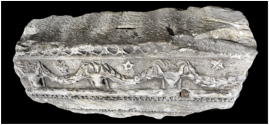 | [6] |
| Description: The architrave was divided into three protruding fasciae, the lowest of which is missing. There is a bead-and-reel above each fascia. The finishing moulding of the architrave features a leaf-and-dart motif. The frieze is decorated with bullheads and garlands. There are rosettes above the garlands. The upper end of the block is decorated with egg-and-tongue (or dart). | ||||||||||||
| 9749 | FWM0391 | 6 | Cornice with consoles | Marble | White colour; coarse-grained with fine-grained veins | Late-Hadrianic period | In situ | Plovdiv | Eastern gate | Asenovgrad | 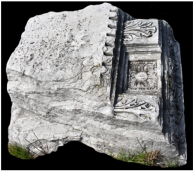 | [6] |
| Description: The main mouldings consist of dentils, consoles with acanthus leaves and coffers, and sima decorated with palmette anthemion. The coffers are framed with bead-and-reel and egg-and-tongue. | ||||||||||||
| 9750 | FWM0392 | 4 | Corinthian pilaster capital | Marble | White colour; coarse-grained | Hadrianic period | In situ | Plovdiv | Eastern gate | Asenovgrad |  | [6] |
| Description: From the honorary arch, above a corner pilaster with two adjacent decorated sides. The capital has a cubic shape, due to which its decorative elements are reduced, namely, the number of acanthus leaves arranged in one row only. The acanthus leaves are of Asiatic type and the helices of Attic type. | ||||||||||||
| 9751 | FWM0393 | 5 | Block with shell decoration | Marble | White colour; coarse-grained | Second century AD | In situ | Plovdiv | Eastern gate | Asenovgrad |  | [15] |
| Description: Part of a blind niche or water basin decorated with a shell motif. | ||||||||||||
| 9752 | FWM0394 | 48 | Pedestal | Marble | White colour; coarse-grained with fine-grained veins | Second half of the second to the first decades of the third century AD | In situ | Plovdiv | Eastern gate | Asenovgrad |  | [14] |
| Description: The upper part is broken off. It is possible that the pedestal was made of a monolithic block together with an Attic-Ionic base (?). | ||||||||||||
| 9753 | FWM0395 | 19 | Corinthian column capital | Marble | White colour; coarse-grained | Severan period | In situ | Plovdiv | Eastern gate | Prokonnesos | 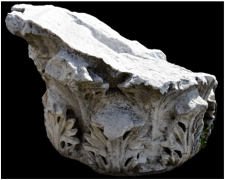 | [14] |
| Description: Corinthian capital, Asiatic type. There are no helices. One of the abacus flowers is replaced by an eagle. The capital is split in two and all corners of the abacus with the adjacent volutes are broken off. | ||||||||||||
| 9754 | FWM0396 | 39 | Block | Marble | White colour; coarse-grained with fine-grained veins | End of the second to the first decades of the third century AD | In situ | Plovdiv | Eastern gate | Asenovgrad | 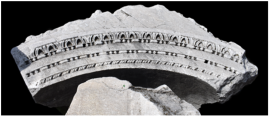 | n/a |
| Description: Form of an arch or vault. The curved moulded part (archivolt) is divided into three protruding fasciae, which end with leaf-and-dart. Above the lower fascia, there is a twisted rope ornament, and above the next two, bead-and-reel. There is a horizontal decoration of egg-and-dart above the archivolt. | ||||||||||||
| 9755 | FWM0397 | 18 | Block | Marble | White colour; fine-grained in a coarse matrix | Hadrianic period (?) | In situ | Plovdiv | Eastern gate | Asenovgrad |  | [5] |
| Description: From a vault, possibly a blind niche. The front curved part (archivolt) is divided into three protruding fasciae. There are no additional ornaments, and the moulding at the upper end is broken off. | ||||||||||||
| 9756 | FWM0398 | 301 | Frieze-architrave | Marble | White colour; fine-grained in a coarse matrix | Severan period | In situ | Plovdiv | Eastern gate | Asenovgrad |  | [15] |
| Description: The architrave is divided into three protruding fasciae. Above the lower fascia there is a twisted rope ornament, and above the next two, bead-and-reel. The finishing moulding of the architrave features a leaf-and-dart motif. The unadorned frieze has a convex profile. The upper end of the block is decorated with egg-and-dart. The soffit is decorated with a wave motif. | ||||||||||||
| 9786 | FWM0431 | n/a | Statue base | Marble | White colour; medium to coarse-grained | First half of the third century AD | Plovdiv Depot | Plovdiv | Eastern gate | Asenovgrad | 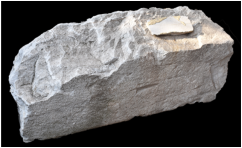 | [15], pp. 160–164 |
| Description: With a Greek inscription. Severely damaged. | ||||||||||||
| 9787 | FWM0432 | 201 | Corinthian column capital | Marble | Greyish colour; medium to coarse-grained | Severan period | Plovdiv Depot | Plovdiv | Eastern gate | Prokonnesos | 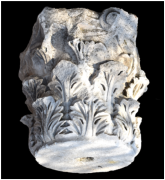 | [15] |
| Description: Normal Corinthian capital, Asiatic type. There are palmette helices on at least one side. One of the abacus flowers is replaced by an eagle. All corners of the abacus with the adjacent volutes are broken off. | ||||||||||||
| 9788 | FWM0433 | n/a | Corinthian column capital | Marble | Greyish colour and grey banding; medium-grained | Severan period | Plovdiv Depot | Plovdiv | Eastern gate | Prokonnesos |  | n/a |
| Description: Normal Corinthian capital, Asiatic type. There are palmette helices on at least one side. One of the abacus flowers is replaced by an eagle. All corners of the abacus with the adjacent volutes are broken off. | ||||||||||||
| 9789 | FWM0434 | 1021 | Monumental relief | Marble | White colour; fine-grained, partly medium-grained | Second half of the second century AD | Regional Archaeological Museum Plovdiv (RAMP) | Plovdiv | Eastern gate | Asenovgrad | 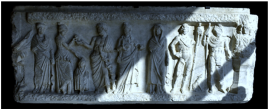 | [20], p. 238 |
| Description: Corner block with figural decoration and an embossed frame on the top and bottom. The relief decoration consists of two corner images and eight human figures between them (including the gods Asclepius, Hygeia, and Telesphorus). | ||||||||||||
| Sample Nr | Type | Grain Size | Texture | Fabric Features | Accessory Minerals | Other Observations | ||||
|---|---|---|---|---|---|---|---|---|---|---|
| Fine | Medium | Coarse | Heteroblastic | Homeoblastic | Mosaic, Mortar, Lineated | Straight, Curved, Sutured | ||||
| FWM0373 | calcite | x | x | mortar | sutured | opaque minerals; mica | deformed twin lamellae—slightly curved; smaller grains and fluid inclusions along the schistosity | |||
| FWM0374 | calcite | x | x | mortar | sutured | opaque minerals; mica | deformed twin lamellae—slightly curved; larger relics (with corroded surroundings) | |||
| FWM0375 | calcite | x | x | mortar | curved | n.a. | straight twin lamellae | |||
| FWM0378 | calcite | x | x | mosaic mainly/ partly mortar | sutured | opaque minerals; quartz (at the lower part) | deformed twin lamellae—slightly curved; the sample is separated into three parts, low, middle, and upper; the lower part is ultra-mylonitic with no larger crystals; the middle part has many larger crystals between the fine matrix; the upper part has a fine matrix with few scattered larger crystals; undulose extinction | |||
| FWM0392 | calcite | x | x | mortar | sutured | opaque minerals; many mica inclusions; quartz | deformed twin lamellae—slightly curved | |||
| Sample Nr | Polarised Light Photos | Transmitted Light Photos |
|---|---|---|
| FWM0373 | 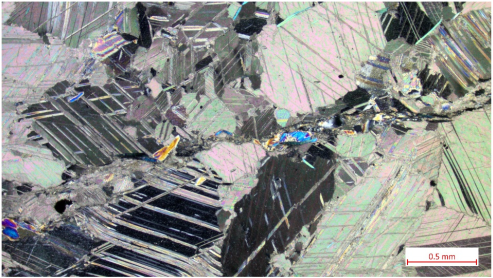 | 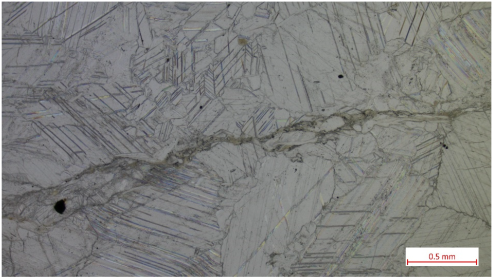 |
| FWM0374 | 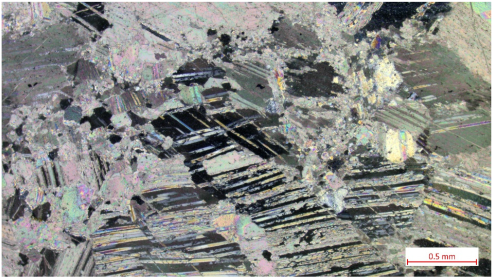 | 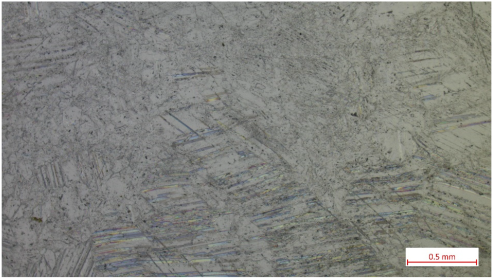 |
| FWM0375 | 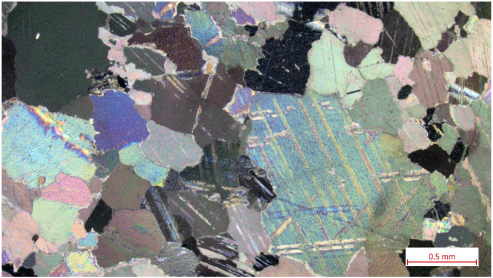 | 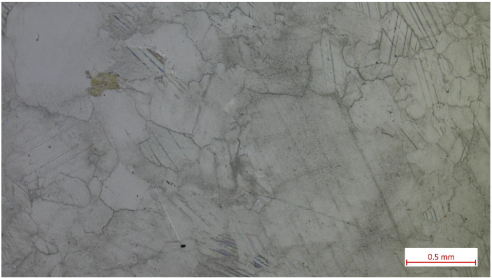 |
| FWM0378 | 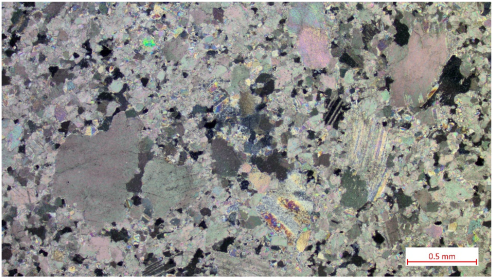 | 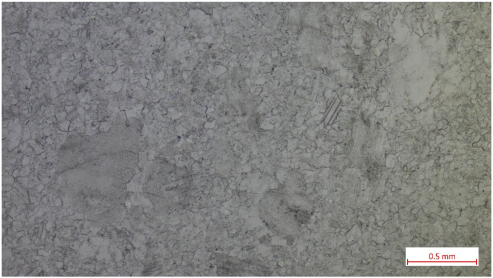 |
| FWM0392 | 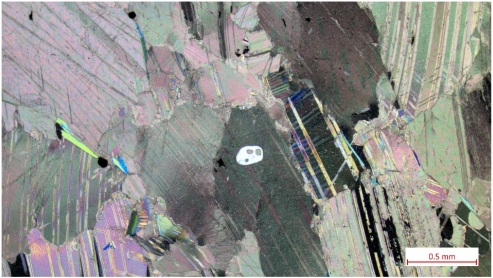 |  |
| Sample | Distance | Abs. Prob. | Rel. Prob. | Provenance | Rel. Prob. | Provenance | |
|---|---|---|---|---|---|---|---|
| 1. choice | 2. choice | ||||||
| 9744 | FWM0386 | 8.2 | 4.1 | 100.0 | Asenovgrad | 0.0 | Prokonnesos |
| 9745 | FWM0387 | 1.0 | 79.0 | 100.0 | Asenovgrad | 0.0 | Prokonnesos |
| 9752 | FWM0394 | 3.1 | 36.8 | 99.4 | Asenovgrad | 0.6 | SE Rhodope |
| 9724 | FWM0366 | 0.9 | 82.5 | 100.0 | Asenovgrad | 0.0 | Prokonnesos |
| 9725 | FWM0367 | 10.0 | 1.8 | 97.8 | Asenovgrad | 2.2 | Prokonnesos |
| 9726 | FWM0368 | 1.3 | 71.5 | 100.0 | Asenovgrad | 0.0 | Prokonnesos |
| 9727 | FWM0369 | 2.9 | 49.6 | 99.9 | Asenovgrad | 0.1 | Prokonnesos |
| 9728 | FWM0370 | 5.5 | 13.7 | 99.0 | Asenovgrad | 1.0 | Prokonnesos |
| 9729 | FWM0371 | 3.9 | 27.2 | 100.0 | Asenovgrad | 0.0 | Prokonnesos |
| 9730 | FWM0372 | 1.5 | 68.2 | 100.0 | Asenovgrad | 0.0 | Prokonnesos |
| 9731 | FWM0373 | 3.6 | 29.7 | 98.5 | Asenovgrad | 1.5 | Prokonnesos |
| 9732 | FWM0374 | 1.6 | 65.7 | 99.9 | Asenovgrad | 0.1 | Prokonnesos |
| 9733 | FWM0375 | 5.3 | 14.8 | 99.8 | Prokonnesos | 0.2 | SE Rhodope |
| 9734 | FWM0376 | 0.4 | 93.1 | 100.0 | Prokonnesos | 0.0 | SE Rhodope |
| 9735 | FWM0377 | 2.5 | 46.2 | 100.0 | Prokonnesos | 0.0 | SE Rhodope |
| 9787 | FWM0432 | 1.0 | 78.5 | 100.0 | Prokonnesos | 0.0 | SE Rhodope |
| 9788 | FWM0433 | 1.3 | 12.1 | 100.0 | Prokonnesos | 0.0 | SE Rhodope |
| 9750 | FWM0392 | 3.7 | 29.1 | 99.9 | Asenovgrad | 0.1 | Prokonnesos |
| 9753 | FWM0395 | 0.9 | 82.1 | 100.0 | Prokonnesos | 0.0 | SE Rhodope |
| 9736 | FWM0378 | 4.6 | 19.9 | 100.0 | Asenovgrad | 0.0 | Prokonnesos |
| 9737 | FWM0379 | 1.1 | 75.4 | 100.0 | Asenovgrad | 0.0 | Prokonnesos |
| 9738 | FWM0380 | 4.0 | 25.3 | 100.0 | Asenovgrad | 0.0 | Prokonnesos |
| 9739 | FWM0381 | 4.6 | 20.3 | 100.0 | Asenovgrad | 0.0 | Prokonnesos |
| 9740 | FWM0382 | 6.6 | 8.4 | 77.1 | Asenovgrad | 22.9 | Prokonnesos |
| 9741 | FWM0383 | 0.9 | 81.0 | 100.0 | Asenovgrad | 0.0 | Prokonnesos |
| 9742 | FWM0384 | 2.2 | 51.6 | 100.0 | Asenovgrad | 0.0 | Prokonnesos |
| 9743 | FWM0385 | 1.5 | 66.0 | 100.0 | Asenovgrad | 0.0 | Prokonnesos |
| 9746 | FWM0388 | 6.3 | 9.5 | 82.6 | Asenovgrad | 17.3 | Prokonnesos |
| 9747 | FWM0389 | 1.0 | 78.4 | 100.0 | Asenovgrad | 0.0 | Prokonnesos |
| 9748 | FWM0390 | 1.6 | 64.1 | 100.0 | Asenovgrad | 0.0 | Prokonnesos |
| 9756 | FWM0398 | 7.2 | 6.4 | 100.0 | Asenovgrad | 0.0 | Prokonnesos |
| 9789 | FWM0434 | 0.9 | 82.0 | 100.0 | Asenovgrad | 0.0 | Prokonnesos |
| 9749 | FWM0391 | 5.0 | 16.8 | 99.5 | Asenovgrad | 0.5 | Prokonnesos |
| 9751 | FWM0393 | 2.4 | 47.7 | 100.0 | Asenovgrad | 0.0 | Prokonnesos |
| 9754 | FWM0396 | 9.9 | 1.9 | 77.2 | Asenovgrad | 20.0 | SE Rhodope |
| 9755 | FWM0397 | 1.2 | 74.1 | 100.0 | Asenovgrad | 0.0 | Prokonnesos |
| 9722 | FWM0364 | 2.7 | 84.4 | 99.4 | Asenovgrad | 0.3 | SE Rhodope |
Disclaimer/Publisher’s Note: The statements, opinions and data contained in all publications are solely those of the individual author(s) and contributor(s) and not of MDPI and/or the editor(s). MDPI and/or the editor(s) disclaim responsibility for any injury to people or property resulting from any ideas, methods, instructions or products referred to in the content. |
© 2025 by the authors. Licensee MDPI, Basel, Switzerland. This article is an open access article distributed under the terms and conditions of the Creative Commons Attribution (CC BY) license (https://creativecommons.org/licenses/by/4.0/).
Share and Cite
Anevlavi, V.; Prochaska, W.; Dakasheva, P.; Dimitrov, Z.; Andreeva, P. Crafting Urban Landscapes and Monumental Infrastructure: Archaeometric Investigations of White Marble Architectural Elements from Roman Philippopolis (Bulgaria). Minerals 2025, 15, 704. https://doi.org/10.3390/min15070704
Anevlavi V, Prochaska W, Dakasheva P, Dimitrov Z, Andreeva P. Crafting Urban Landscapes and Monumental Infrastructure: Archaeometric Investigations of White Marble Architectural Elements from Roman Philippopolis (Bulgaria). Minerals. 2025; 15(7):704. https://doi.org/10.3390/min15070704
Chicago/Turabian StyleAnevlavi, Vasiliki, Walter Prochaska, Plamena Dakasheva, Zdravko Dimitrov, and Petya Andreeva. 2025. "Crafting Urban Landscapes and Monumental Infrastructure: Archaeometric Investigations of White Marble Architectural Elements from Roman Philippopolis (Bulgaria)" Minerals 15, no. 7: 704. https://doi.org/10.3390/min15070704
APA StyleAnevlavi, V., Prochaska, W., Dakasheva, P., Dimitrov, Z., & Andreeva, P. (2025). Crafting Urban Landscapes and Monumental Infrastructure: Archaeometric Investigations of White Marble Architectural Elements from Roman Philippopolis (Bulgaria). Minerals, 15(7), 704. https://doi.org/10.3390/min15070704







